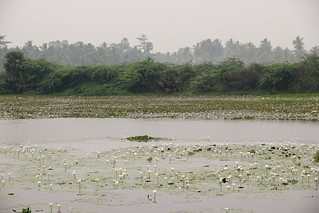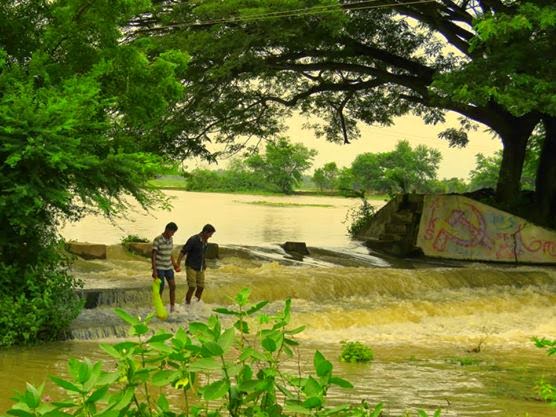
The union territory (UT) Of Puducherry is, for the most part, enveloped on three sides by the state of Tamil Nadu with the Bay of Bengal framing its eastern face. A total of 84 irrigation tanks--part of the Gingee and Pennaiyar river systems--dot the territory’s landscape.
Recently, the Puducherry Department of Science, Technology and Environment (DSTE) secured a grant of Rs 17 crore from NABARD for renewing water bodies--52 in all (20 tanks and 32 ponds). Villages were selected and tanks were finalised without consulting any of the tank users’ associations. In contrast, the government of Puducherry-funded Tank Rehabilitation Project-Pondicherry (TRPP) functioned efficiently for five years between 2004 and 2008 with a budget of under three crores per year for the upkeep of all 84 tanks in Puducherry.
Approval of the steering committee, the apex body responsible for deciding upon matters relating to irrigation tanks in Puducherry, was bypassed altogether. The committee was set up a couple of years ago to ensure stakeholder participation--command area farmers, tank users and agricultural labourers--before deciding upon any matter relating to irrigation tanks. Politicians, along with corrupt officials and department chiefs, are to be blamed for such brazen circumvention, villagers say.
 “The village selection was almost comical. The village of Seliamedu, where large-scale conversion of farmland into real estate plots is increasing by the day, was among the chosen few. What more, 17 crores for just 20 tanks. If left to us, we could revamp all 84 tanks for half the cost,” rues V. Chandrasekhar, president of the Bangaaru Vaickal Neeraadhara Koottamaippu, a cluster association representing six sluice associations of the massive Bahour tank. The cluster association is responsible for the upkeep of the Bahour tank as well as the Bangaru feeder channel which routes water into the main tank from river Pennaiyar.
“The village selection was almost comical. The village of Seliamedu, where large-scale conversion of farmland into real estate plots is increasing by the day, was among the chosen few. What more, 17 crores for just 20 tanks. If left to us, we could revamp all 84 tanks for half the cost,” rues V. Chandrasekhar, president of the Bangaaru Vaickal Neeraadhara Koottamaippu, a cluster association representing six sluice associations of the massive Bahour tank. The cluster association is responsible for the upkeep of the Bahour tank as well as the Bangaru feeder channel which routes water into the main tank from river Pennaiyar.
Why are tanks more popular here?
Due to the non-perennial nature of most rivers, tank irrigation is common in south India. In order to maximise the efficiency of water utilisation, an intricate system of inter-linked tanks were designed where water from the nearby rivers would proceed to fill tanks one by one in a cascading manner. Once a tank in the system got filled up to the appropriate level, the excess water would flow out into the next one in the system along the earthen channels. Topography and land gradient were studied to ensure this flow of water.
The states of Andhra Pradesh, Karnataka and Tamil Nadu, along with the small union territory of Puducherry, boast of such an elaborate system of man-made tanks that have managed to irrigate around 92 percent of all agricultural fields till the 1970s.
The large-scale shift to groundwater for irrigation is a recent phenomenon. Tubewells were practically absent in the 1950s, entering the irrigation scene only a decade later. While tubewells irrigated a measly 0.135 million hectares of land in 1960-61, their contribution rose tremendously to 26.013 million hectares in 2008-09.
The ease with which groundwater can be accessed along with scant regulation has made tank irrigation seem rather dispensable. This could not be further from the truth.
Tank rehabilitation project
Back in 1999, with financial support from the European Union, the Puducherry government undertook a massive exercise to rehabilitate all existing tanks in the UT. The TRPP focused on desilting water bodies as well as irrigation and feeder channels with the active participation of the community.
The public works department (PWD) along with the agriculture, revenue and local administration departments ran the project. The advice of non-governmental organisations (NGO) was sought, and Auroville’s Water Harvest, along with the Centre for Ecology & Rural Development (CERD), were tasked with mobilising the community and ensuring their active participation at the start of the project with a few more organisations roped in at later phases. It put in place a robust participatory tank management system with tank users' association (TUA) at its core. Many of these associations continue to remain active even today.
 Tenacious farmers of Bahour
Tenacious farmers of Bahour
As Benjamin Disreali once said, ‘Justice is truth in action’, and Chandrasekhar’s association wouldn’t stop until the bureaucracy’s follies are exposed. Repeated petitioning on behalf of all the farmers and their associations brought him to the Puducherry lieutenant governor (LG), Kiran Bedi’s door step. After the LG was apprised of past rehabilitation efforts and the eagerness of enterprising tank associations in being part of the process, a meeting of the steering committee was convened a day after. With just a day’s notice, Chandrasekhar’s team managed to bring all 84 tank associations up to speed, and representatives from every association were present for the consultative meeting.
“We no longer have the luxury of waiting for someone to fight our battles; we have to get down and fight for what’s ours. People need to get together, discuss, build capacity and tap the traditional knowledge which is available in plenty,” adds farmer Arjunan, from the Keezhparikalpet tank association in Bahour.
The PWD, initially was to have a free hand in choosing contractors. But the tank associations argued that such a system only bred corruption, and requested the LG to entrust them with all renovation works. Paying heed to the associations’ plea regarding their involvement, the LG ordered all rehabilitation works to be taken up by the tank associations themselves. It was also agreed that apart from the 20 tanks as per the original NABARD plan, all 84 tanks will now be taken up for rejuvenation with the PWD’s own funds for irrigation.
The long road to the PWD
With the northeast monsoon fast approaching, Chandrasekhar feels it is imperative to get the feeder channels desilted before the rains. “Most large tanks can be desilted only in the dry season. So, before the rains, all that can be done is channel desilting and it needs to be done soon,” he adds.
While work orders were issued to most of the associations, officials withheld the order for the Bangaru cluster association and the six sluice associations of the Bahour tank. “The programme is centrally sponsored. It has the sanction of the UT’s lieutenant governor. Yet, work orders were withheld at the behest of the political leaders. The PWD minister and the MLA from Bahour wanted the contracts to be handed over to private parties of their choice,” says Chandrasekhar.
The Bahour tank is dependent on the Bangaru channel for its runoff and river water supply. Hence, it is imperative that the Bangaru channel is renovated before any of the other structures in the Bahour cascade system.
 “One of the main reasons for the TRPP’s success was the complete de-linking of participatory irrigation management related works from the political process. And, we have ex-chief minister N. Rangaswamy to thank; all orders came directly from his desk, ensuring minimum political interference throughout,” he adds. In fact, in the current set up, tank users’ associations are the most legitimate agencies to take up any kind of participatory irrigation management works given their superlative understanding of ground realities and traditional knowledge that has been handed down for generations. Unless political and official non-interference is ensured, meaningful rehabilitation work will continue to remain a distant dream.
“One of the main reasons for the TRPP’s success was the complete de-linking of participatory irrigation management related works from the political process. And, we have ex-chief minister N. Rangaswamy to thank; all orders came directly from his desk, ensuring minimum political interference throughout,” he adds. In fact, in the current set up, tank users’ associations are the most legitimate agencies to take up any kind of participatory irrigation management works given their superlative understanding of ground realities and traditional knowledge that has been handed down for generations. Unless political and official non-interference is ensured, meaningful rehabilitation work will continue to remain a distant dream.
The LG has since granted him audience and ordered the Chief Engineer of the PWD to issue work orders with immediate effect. Strong-willed farmers score; corrupt officials nada!
Taking on the mining mafia
The association has been active in keeping the Puducherry LG informed of all the afflictions the Pennaiyar has had to endure. Despite the National Green Tribunal’s (NGT) ban on sand mining in the area, it carries on without much difficulty. The NGT had ordered bunds to be strengthened along the river banks to prevent trucks and carts from entering. Bunds have since been broken and the accused function with impunity.
According to the association’s figures, nearly 1000-1500 sand-laden bullock carts ply in the area on weekends alone, all through fully-staffed check posts. “They have orders from high up the chain, none other than welfare minister Kandasamy and public works minister Namasivayam,” adds Chandrasekhar. Villagers claim that neither the police nor the village officers are ready to take action on the offenders.
But, Chandrasekhar and his partners are in no mood to yield. Emails and phone calls to the LG’s office continue and the associations have vowed to not rest until justice is served.
“With bountiful arrangements for tank irrigation, our ancestors ensured that Bahour was crowned the undisputed rice bowl of Puducherry. But my generation bled the ground dry. Waterbodies and public spaces were taken for granted and encroached upon. Now we fight for our future generations’ welfare and we do not have a choice; we just cannot give up,” laments Pavadai, a concerned farmer from Bahour.